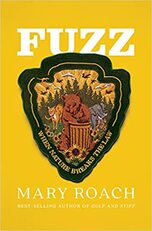Author: Mary Roach
ISBN: 9781324001935
APA Style Citation
Roach, M. (2021). Fuzz: When nature breaks the law. New York, NY: W.W. Norton and Co.
Buy this book
https://www.amazon.com/Fuzz-When-Nature-Breaks-Law/dp/1324001933
| fuzz_activity_.pdf |
In Mary Roach's most recent publication, she again combines her humor and love of science to deliver a hilarious and unexpected book about animals breaking the law. The book pointedly asks humans to consider how humans and animals can better live together when we continue to invade their territory.
Roach starts the book with a chapter titled Maul Cops. She describes her attendance at a Canadian forensics conference in which the order of the day was to look at mutilated mannequins to determine what type of wild animal inflicted their wounds. They eventually take their knowledge to the field to determine and collect evidence and eventually try to track down the animal culprit. Bear attacks are becoming more common as their territory becomes smaller and smaller due to developments edging in on their territory. Most bear break-ins are misdemeanors in which they simply steal food from cabinets or the refrigerator. Roach and Colorado Wildlife Service officer Stuart Breck find a bear in a back alley of a restaurant in Aspen, Colorado, a phenomenon that is becoming more and more frequent. Restaurant workers often fail to secure the garbage receptacles, and bears come looking for food. When they find it, they will likely return again and again. Things turn ugly when they are startled by a person while eating or feel trapped.
Roach's research takes her to India, where there is a constant struggle with rhesus monkeys breaking into people's homes, sometimes to grab food and run. Other times the monkeys break into homes, seemingly wreak havoc, and leave like the one that knocked a rice cooker off a counter and left. Additionally, many rhesus monkeys have become expert pickpockets. Because the population of monkeys is expanding but killing the animals is not an option, officials are looking into ways to implement large-scale birth control in the Indian monkey population. Elephant and leopard attacks are also becoming more common in India as people move into the animals' habitats.
Roach discusses arboreal manslaughter when trees die and fall on people. While some tree advocates oppose trimming old forest trees, Roach explains that this is necessary because a dying tree can topple down on top of unsuspecting hikers and murder them without warning. While no tree has yet been charged with premeditated murder, this precedent could change in the future.
Roach's final chapter deals with a wildlife nuisance far more common for most people, rodents. She meets with researchers trying to change the genetic make-up of rats to make it more difficult for them to breed. The challenge to this is that more than one male fertilizes many litters of mice, and it is tremendously difficult to keep track of the mice with the genetic modification. Because so many other animals depend on rats and mice for food, the program's goal is not to eradicate the rodent population but rather to limit reproduction. Other researchers are working on a more humane way to eliminate the rodent population from disturbing human homes. Katherine Horak is developing a bait that kills but contains no poison. It works by targeting the species genome by interfering with the animal's RNA. Roach contends that this would be a more humane way to eliminate rodents, and many companies have moved away from glue traps that often involve the rodent chewing off a limb to break free or dying a slow death. Roach argues that if humans are going to be the killers, we have an obligation to at least be humane murderers.
Even if you are not interested in wildlife or science, this book is endlessly entertaining. It provides the important message of conserving the wildlife population while served on a platter of witty banter and amusing anecdotes.
Other Resources:
Author's website
https://maryroach.net
NPR Interview with Mary Roach
https://www.npr.org/2021/09/19/1038681779/what-happens-when-nature-breaks-the-law-mary-roach-tells-you-in-new-book-fuzz
INFORUM: Conversation with Mary Roach
https://www.amazon.com/Fuzz-When-Nature-Breaks-Law/dp/1324001933
Psychological Figures and Concepts
Jane Goodall
Animal ethics
CRISPR
Genetic modification
Genome

 RSS Feed
RSS Feed